 Image search results - "cat" Image search results - "cat" |

Cat on the roof. Meow is what you first hear in the museum. Its name is "Mamesuke." Actually a robot cat whose head can move up and down.
|
|

Exhibition catalogs 図録Order from PhotoGuide Japan's iStore.
|
|

Temple office sells souvenirs such as the maneki neko beckoning cat in various sizes (and prices).
|
|

Temple office sells maneki neko beckoning cat in various sizes (and prices).
|
|

Gate to Maneki Neko Beckoning Cat Temple. There are a few theories (or legends) as to how the maneki neko (Beckoning Cat) was created. One theory comes from this temple.
|
|

Maneki Neko Beckoning Cat Temple is a small worship hall dedicated to the beckoning cat. On the left of the temple, notice a little roofed shelf. 猫観音を祀る招猫殿
|
|

Inside Beckoning Cat Temple. The altar's objects of worship are numerous beckoning cat dolls.
|
|

One day, Lord Ii Naotaka was doing falconry and was on his way home when it started to rain. He sought shelter under a tree at the temple. Then he saw a cat raising its paw...He went to the cat and then lightning struck the tree he was standing under. In appreciation, Naotaka gave donations to the temple.
|
|

On the left of the Beckoning Cat Temple is a shelf where you can offer your lucky cat after it has brought you good luck.
|
|

Shelf for beckoning cats, maneki neko at Gotokuji temple in Setagaya, Tokyo.
|
|

Shelf for beckoning cats, maneki neko. Gotokuji temple, Setagaya, Tokyo.
|
|

Beckoning cats, maneki neko, which did their duty for their owners who now offer them to the temple as a gesture of thanks. Gotokuji temple, Tokyo.
|
|

Gotokuji temple votive tablet. This cat connection with Ii Naotaka gave rise to Hiko-nyan, the official mascot of Hikone, Shiga Prefecture.
|
|
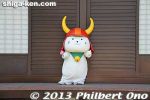
Hiko-nyan, the official mascot for Hikone Castle's 400th anniversary in 2007. He proven to be so popular that he has been retained as the city's official mascot. Basically a white cat with a horned samurai helmet. ひこにゃんOne of the most famous mascots in Japan.
|
|
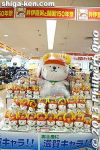
Hiko-nyan merchandise in Heiwado
|
|
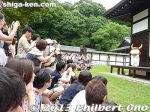
Hikone's super popular official mascot Hiko-nyan appears every day outside Hikone Castle Museum (photo) or in front of the main castle tower. A large crowd gathers each time.Hiko-nyan was the official mascot for Hikone Castle's 400th anniversary in 2007. He proven to be so popular that he has been retained as the city's official mascot.
|
|
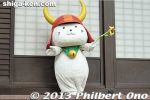
Hikone's official mascot Hiko-nyan appears three times daily for a 30-min. show: 10:30 am and 1:30 pm in front of the main castle tower (tenshu) and at 3:00 pm outside Hikone Castle Museum.According to legend, one day, Ii Naotaka, the third lord of Hikone Castle, was doing falconry in Tokyo and was near a temple when he saw this cat raising its paw. He was led inside the temple where he was able to rest inside. A major thunderstorm ensued, and the cat saved him from getting wet.
|
|
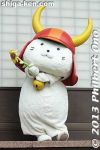
Hiko-nyan does not talk or even "meow." He speaks through a handler or translator. Basically, he (or it) just struts around and makes cute poses with or without a prop.Another legend says that as soon as the cat beckoned Naotaka into the temple, lightning struck the tree where he was standing. Thus, the cat saved his life.
This legendary cat connection gave birth to the idea behind Hiko-nyan. This same legend is also one theory for the origin of the ubiquitous beckoning cat you see at shops and restaurants in Japan. The beckoning cat can be called Hiko-nyan's cousin.
|
|

"Hiko" refers to Hikone, and "nyan" is a baby word for cat. Hiko-nyan's appearance schedule is here.If it rains, Hiko-nyan appears at the Castle Museum. Hiko-nyan is a white cat wearing a red samurai helmet with horns, modeled after the one worn by Lord Ii Naomasa, the first lord of Hikone Castle.
Hiko-nyan also makes guest appearances at various events to promote Hikone. He has even traveled to Hawaii to appear in a Japan parade in Waikiki.
|
|
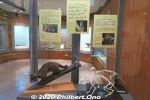
The center's main exhibit is the stuffed Iriomote wildcats.
|
|
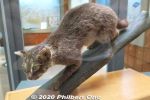
Iriomote is famous for the Iriomote wildcat (イリオモテ ヤマネコ). Endemic to Iriomote and critically endangered.
|
|
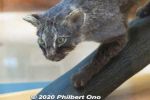
Only 100 or so left on the island. They are nocturnal and have stubby legs and a thick tail. Discovered relatively recently in 1965.
|
|
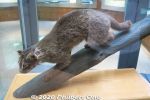
There's no zoo, etc., where we can see a live Iriomote cat. They only have stuffed Iriomote cats here at the Iriomote Wildlife Conservation Center.
|
|
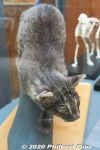
In the past, they did have a live Iriomote cat here, found injured on the road and treated here.
|
|

Characteristics of the Iriomote wildcat.
|
|

Characteristics of the Iriomote wildcat.
|
|

Even though the Iriomote cat is all over Iriomote as a tourist symbol, we can't see any live ones.
|
|
|

Life cycle of Iriomote wildcat.
|
|
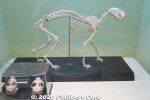
Skeleton of Iriomote wildcat.
|
|
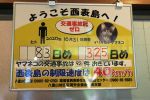
Roadkill of Iriomote cats is a problem especially since they are nocturnal and Iriomote roads are dark. Residents are told to drive slowly at night.
|
|

The drive between the airport and central Ishigaki is largely rural with farmland and cattle.
|
|

Kotohira Shrine has this unique affiliate shrine named "Kishima Shrine" (木島神社) which is the left half of this building. (The right-half shrine is Sarutahiko Shrine [猿田彦神社] for the god of transportation and directions.)Kishima Shrine is unique in Japan for these two koma-neko cat guardians. Shrines usually have koma-inu lion-dog guardians (to ward off evil spirits), but only this shrine in all of Japan has cat guardians instead.
|
|
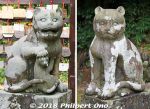
Kishima Shrine has koma-neko cat guardians because silk farmers in the 19th century kept cats to protect their precious silkworms and cocoons from rats. Rats were a major problem for the silk industry.They ate the silk cocoons and worms. So cats saved the local silk industry.
The left cat is the mother (holding a kitten), and right cat is the father. Also respectively "A" and "un."
These koma-neko cat guardian statues were donated in 1832 by silk merchants and wholesalers such as the Tonomura family (外村家一族、岩滝のちりめん問屋、山家屋の小室利七) who were textile merchants from Higashi-Omi (Gokasho), Shiga Prefecture.狛猫
|
|
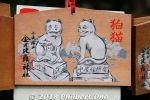
Koma-neko ema prayer tablet.
|
|
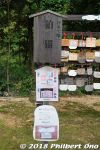
"Koma-neko Unique in Japan"
|
|
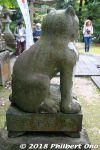
Back view of Koma-neko.
|
|
|
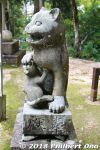
The left koma-neko cat is the mother (holding a kitten).
|
|
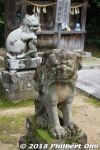
Koma-inu lion dog also protects the shrine.
|
|

Nankun-sha cat shrine (楠珺社).
|
|

Nankun-sha cat shrine (楠珺社).
|
|

Inside Nankun-sha cat shrine (楠珺社).
|
|

Nankun-sha cat shrine altar (楠珺社). It promotes "Hattatsu" worship. At Sumiyoshi Taisha, Osaka. 初辰まいりYou supposed to come here and worship monthly and collect a total of 48 cat figurines over a period of 24 years. Then you'll get the jackpot of family safety and business prosperity. It's based on a play of words with "48" (shijuhachi) that can be pronounced similarly to "shiju-hattatsu (始終発達) which means "constant advancement or development."
|
|

They have tiny, medium, and large cat statues that you can collect.
|
|

Tiny beckoning cat figurines at Nankun-sha cat shrine at Sumiyoshi Taisha.
|
|

Larger beckoning cat figurines at Nankun-sha cat shrine at Sumiyoshi Taisha.
|
|

About Hattatsu worship. 住吉大社 初辰まいり
|
|

About Hattatsu worship. 住吉大社 初辰まいり
|
|

Small cat figurines for sale.
|
|

Cat rice paddles.
|
|

Decorative paddles with a cat.
|
|
|
|